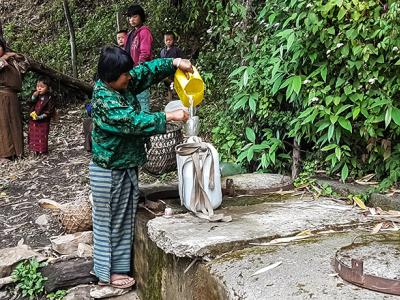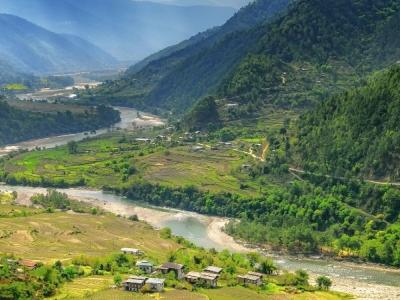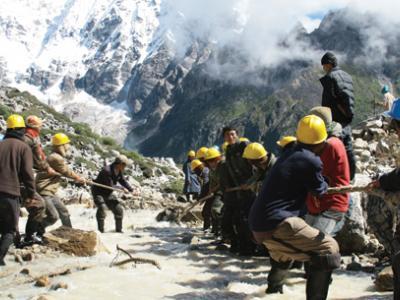Bhutan is a small, land locked country located in the fragile eastern Himalayan ecosystem for which climate change is not just an environmental problem but a serious challenge to sustainable development and the livelihoods of its people. However, the environment in Bhutan is one of most pristine in Asia with clean air, water and primeval forest. Around 70 per cent of the country is forested (much of it primary forests), and approximately 80 per cent of the country’s population depends on subsistence farming for their livelihoods (RGB, 2006). Bhutan’s hydropower production—much of which it exports to India—is described as the backbone of the country’s economy, and there are early concerns that this resource may be adversely impacted by climate change (RGB, 2008).
With high growth rates in population, unchecked rural to urban migration, increased population density in the towns and cities, rapid increases in imports of cars, and rising demand for fuel wood, roads and building construction, the future suggests many negative effects on environmental assets, which can further expose the population to climate change vulnerabilities. Some of Bhutan's adaptation projects include: a disaster management strategy, a weather forecasting system, landslide management and flood prevention and community-based forest fire management and prevention.
Bhutan’s development is highly dependent on climate-sensitive sectors such as agriculture, hydropower, and forestry. The most significant impact of climate change in Bhutan is the formation of supra-glacial lakes due to the accelerated retreat of glaciers with increasing temperatures. The risk of potential disasters inflicted by Glacial Lakes Outburst Floods (GLOFs), which pose new threats to lives, livelihoods and development, is mounting as the water levels in several glacier lakes approach critical geostatic thresholds. Although current disaster management policies, risk reduction, and preparedness plans in Bhutan are able to address recurrent natural hazards in the country, they are not yet prepared to deal with the new GLOF threat. Bhutan’s entire northern region has glacier/snow-fed lakes near its mountaintops. With a majority of Bhutan’s population and infrastructure development concentrated in large river valleys, climate-induced GLOFs could cause significant human and economic devastation. Rising mean temperature, attributed to climate change, are the main cause of glacial retreat and are correlated with faster rates of glacier melt. The result is that glaciers in Bhutan are receding at a rate of almost 30-60 meters per decade. The melting ice from these receding glaciers is increasing the volume of water in glacial lakes, and the melting of ice-cored dams is destabilizing them, pushing the hazard risk for GLOFs to critical levels.
A. Adaptation Needs and Priorities
Bhutan’s climate varies considerably from one area to another due to dramatic changes in topography. The country has three climatic zones: (a) the southern plains, which are subtropical and characterized by high humidity and heavy rainfall; (b) the central belt of flat valleys characterized by cool winters and hot summers, with moderate rainfall; and (c) high valleys with cold winters and cool summers (RGB, 2006). This complex climate is due mainly to the country’s situation at the periphery of the tropical circulation in the north and on the periphery of the Asian monsoon circulation in the south. Summer monsoons typically last from late June through to late September, at times causing flash floods and landslides; monsoons generate approximately 70 per cent of the annual rainfall in Bhutan.
Modeling of the projected impacts of climate change has not yet been undertaken for Bhutan due to a paucity of data and a lack of capacity (RGB, 2009). The meteorological network in the country is limited, with stations limited to inner and southern Bhutan; these stations require manual recording. Climate modeling in Bhutan also faces the additional challenge of handling its complex mountain topography and the implications this geography has on local climatic conditions (RGB, 2009). However, the country’s National Adaptation Programme of Action (NAPA) anticipates that an increasing trend of precipitation will occur (RGB, 2006). This conclusion is consistent with climate modeling for South Asia as a whole, which project that the region will experience: a median increase in
temperature of 2.3oC by 2100; that the greatest amount of warming will take place at higher altitudes; precipitation during the dry season will decline by 5 per cent by 2100, but during the remainder of the year will increase by a median of 11 per cent (RGB, 2009).
Bhutan’s National Environment Strategy, “The Middle Path,” highlights hydropower development, industrial growth and intensification of agriculture as the three major avenues for sustainable development in Bhutan (RGB, 1998). Tourism is also an important economic sector. All of these sectors are highly climate sensitive and vulnerable to the adverse effects of climate change. Hydropower critically depends on predictable and stable patterns of precipitation which will be perturbed due to climate change. Subsistence farmers will be directly affected by temperature changes and monsoon patterns that are less predictable as a result of climate change. Bhutan’s roads and other important infrastructure will suffer more damage from landslides and flashfloods. The rapid melting of glaciers, besides affecting the base flow of Bhutan’s rivers, will dramatically increase the risk of GLOFs. Bhutan’s extensive forest cover, rich biodiversity and clean water resources will also be affected by climate change, which will then negatively impact the tourism and service sectors.
As a part of the NAPA process, the country has identified key climate change vulnerabilities by sector as presented below:
Forestry and biodiversity. Climate change vulnerabilities include:
- Drought combined with more frequent lightning may cause greater risk of forest fires;
- Possible loss of endemic plant and animal species;
- Change in migratory pattern of transboundary wildlife, which may result in loss/degradation of forest ecosystems and reduction of alpine range lands; and
- Possible increase in vector-borne disease in wildlife due to warming.
Agriculture. Vulnerabilities include
- Possible crop yield instability, loss of production and quality (due to variable rainfall, temperature, etc.), decreased water availability for crop production, and increased risk of extinction of already threatened crop species (traditional crop varieties);
- Loss of soil fertility due to erosion of top soil and runoff; loss of fields due to flash floods; and loss of soil and nutrients;
- Crop yield loss (flowers & fruit drop) to hailstorms; deteriorated produce quality (fruit & vegetables) due to unanticipated heavy rains and hailstorms;
- Delayed sowing (late rainfall), as well as damage to paddy and potato crops due to sudden early and late spring frost respectively; and
- Outbreak of pests and diseases in fields and during storage where they were previously unknown.
Natural disaster and infrastructure. Vulnerabilities include:
- Debris-covered glaciers forming huge moraine dam lakes that ultimately lead to GLOFs (i.e. flash floods and landslides, heavy siltation of the rivers, and other geotechnical hazards);
- GLOF will affect “essential” infrastructure, namely: (1) Hydropower systems (generation plants, transmission and distribution infrastructure), Bhutan’s main export product; (2) industrial estates/infrastructure; (3) Human settlements: urban, suburban and rural settlements; (4) Historical and cultural monuments: dzongs, monasteries, chortens, etc.; and (5) Public utilities: roads, bridges and communication systems
Water (and energy). Vulnerabilities include:
- Temporal & spatial variation in flow, notably affecting electricity production/exports due to disruption of average flows for optimum hydropower generation;
- Increased sedimentation of rivers, water reservoirs and distribution network, affecting notably irrigation schemes’ productivity/ agricultural crop yields;
- Reduced ability of catchment areas to retain water/increased runoffs with enhanced soil erosion (deterioration of environment); and
- Deterioration of (drinking) water quality.
Human health. Vulnerabilities include:
- Loss of life from frequent flash floods, GLOF and landslides;
- Spread of vector-borne tropical disease (malaria, dengue) into more areas (higher elevations) with warming climate; and
- Loss of safe (drinking) water resources increasing water borne diseases.
B. National Level Policies and Strategic Documents
Bhutan completed its Initial National Communication to the United Nations Framework Convention on Climate Change (UNFCCC) in 2000. It identifies the key climate change concerns for the country and highlighted the fact that Bhutan is one of few countries that has the potential to increase carbon sequestration. These issues were further clarified in the Bhutan’s 2006 NAPA. This document was prepared under the direction of Bhutan’s National Environment Commission and supported by Task Force and Working Groups from five key areas: agriculture and livestock; forestry and biodiversity; health; water resources and energy; and natural disasters and infrastructure. The NAPA process was transparent and included regional and grassroots level consultations. Although the vulnerability analysis could not have adequate scientific grounding (primarily due to lack of country-specific hydro-meteorological data), this weakness was largely compensated by the robust process that was followed to identify national priorities and actions. The concerned sectors and the Department of Aid and Debt Management will be the main custodians of Bhutan’s NAPA and will foresee its implementation with input from stakeholders in the government and local communities. The Bhutan NAPA is conceived as a living document, which may be from time to time be updated once the prioritized projects are implemented.
C. Current Adaptation Action
There appear to be a limited number of adaptation projects ongoing within Bhutan. These projects are focused on the areas of risk reduction, water, policy formulation and health, and correspond with the priority adaptation actions identified in Bhutan’s NAPA. Funders of these projects include the Netherlands, Germany, Japan, Switzerland and the UK.
D. Proposed Adaptation Action
The NAPA process in Bhutan considered some 55 project ideas, which were narrowed down to 22 and eventually to nine top-priority adaptation projects. They primarily focus on disaster risk management, freshwater supply, climate information services, as well as agriculture, human health and forestry.












